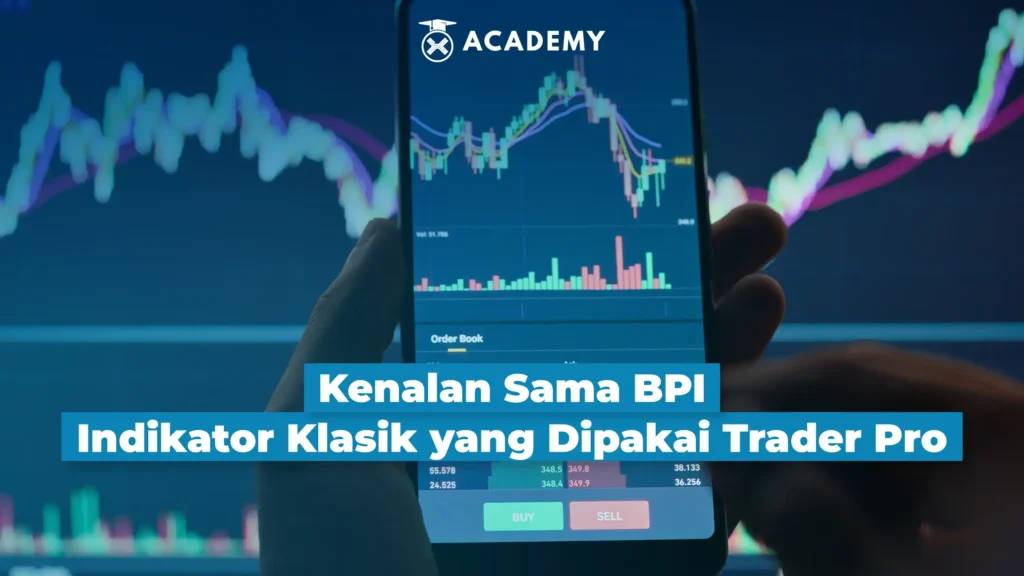Sometimes the index continues to rise, but the majority of stocks stagnate or even fall. This often leaves investors confused: is the market truly bullish, or is it just an appearance?
This is where the Bullish Percentage Index (BPI) plays a crucial role: it helps us understand the market’s internal conditions, beyond simply looking at the index numbers.
To better understand the Bullish Percentage Index (BPI), let’s take a look at the full review below!
What is the Bullish Percentage Index (BPI)?
Apa Itu Bullish Percentage Index (BPI)?
 Meet the Bullish Percentage Index (BPI), a Classic Indicator Used by Pro Traders. The Bullish Percentage Index (BPI) is a market breadth indicator used to measure the internal strength of a stock market index.
Meet the Bullish Percentage Index (BPI), a Classic Indicator Used by Pro Traders. The Bullish Percentage Index (BPI) is a market breadth indicator used to measure the internal strength of a stock market index.
This indicator calculates the percentage of stocks in an index, such as the S&P 500, Dow Jones, or Russell 2000, that are currently showing buy signals based on the Point & Figure (P&F) charting method.
The basic concept is simple: if more stocks in the index are showing buy signals on the P&F chart, the BPI will rise. Conversely, if the majority of stocks are showing sell signals, the BPI will fall.
Therefore, the BPI is considered a tool that can help investors understand whether the market is indeed bullish overall or simply appears so because a small number of large-cap stocks dominate the index’s movement.
This indicator was first developed by Abe Cohen in the mid-1950s and was initially applied to stocks on the New York Stock Exchange (NYSE).
Cohen is also known as the first editor of ChartCraft, which later evolved into the popular market analysis service Investors Intelligence.
Over time, the BPI signal was further developed by Earl Blumenthal in the 1970s and Mike Burke in the early 1980s.
The advantage of the BPI lies in its Point & Figure chart. This method recognizes only two clear signals: buy or sell.
There are no gray areas, making this indicator more definitive and easier to read than some other technical indicators.
From this perspective, six types of signals are recognized within the BPI: bull confirmation, bull alert, bull correction, bear confirmation, bear alert, and bear correction.
Each of these signals reflects the ongoing trend and can be used as a guide to reading market momentum.
Interpretatively, a BPI reading above 70% is generally considered to indicate very high market optimism or overbought conditions, potentially followed by a price correction.
Conversely, when the BPI falls below 30%, it reflects extremely pessimistic or oversold market sentiment and could signal a potential reversal.
However, this indicator is not available on all charting platforms. BPI charts can be found on StockCharts.com, including visualizations of its movement against indices like the Dow Jones.
With the BPI, investors can assess the technical condition of the majority of stocks in the index, rather than simply looking at the index’s movements, which may be driven by a few large stocks.
Workflow Explanation
The Bullish Percentage Index (BPI) calculation process is quite simple, yet extremely useful for understanding market conditions from a technical perspective.
Each stock or asset in an index is analyzed using the Point & Figure (P&F) charting method, which utilizes traditional box sizing and the 3-box reversal principle.
Each stock has only two possible positions: a buy signal or a sell signal. If the stock price rises and generates a buy signal based on the P&F chart, the stock is recorded as bullish (value 1). Conversely, if there is no buy signal, meaning a sell signal, the stock is recorded as non-bullish (value 0). The BPI formula can be written as follows:
BPI = (Number of stocks with buy signals / Total number of shares) × 100%
The results are displayed in graphical form on a scale of 0% to 100%. For example, if the BPI is at 70%, it means that 70% of the stocks in the index are showing buy signals, while the remaining 30% are showing sell signals.
If the following week the figure drops to 64%, only 64% of stocks are still showing buy signals, while the remaining 36% have switched to sell signals.
A decrease in the BPI value means that more stocks are losing their upward momentum and more are starting to show signs of price decline.
This is an early signal that money is starting to leave the market, and investors need to be more cautious, shifting their focus from aggressive profit-seeking to asset preservation strategies.
What is the BPI Used For?
The Bullish Percentage Index (BPI) is a technical indicator that not only displays numbers but also provides a more in-depth picture of the internal market conditions. Here are some of the main functions of the BPI in technical analysis:
1. Market Sentiment
The BPI can provide an indication of how optimistic or pessimistic market participants are about current conditions. When a high percentage of stocks are signaling a buy, it means the majority of market participants have a positive outlook and market sentiment is strong.
Conversely, if only a few stocks are signaling a buy, it indicates that market sentiment is weakening.
2. Market Timing
One of the strengths of the BPI is that it helps investors determine the right time to enter or exit the market. When the BPI is above 70%, the market tends to be overbought, indicating a significant potential for a correction.
Conversely, if the BPI falls below 30%, the market can be considered oversold, opening the opportunity for a price rebound.
3. Trend Confirmation
The BPI can also be used as a trend confirmation tool. Traders often use this indicator to strengthen signals from other strategies.
For example, if the price is in an uptrend and the BPI is also increasing, the trend is considered to have strong support from many stocks in the index.
4. Divergence Detector
One important signal from the BPI is when divergence occurs, namely when the main stock index rises, but the BPI decreases.
This indicates that the index’s rise may be supported by only a small number of large stocks, while the majority of stocks are actually starting to weaken.
This condition can be an early warning that the trend is weakening and the market is at risk of a reversal.
How to Read BPI Figures and Their Signals
The Bullish Percentage Index (BPI) figure is presented as a percentage, ranging from 0% to 100%.
This range can provide a clear picture of overall market conditions. Here is a general guide to reading BPI levels and their interpretations:
| BPI Value | Meaning & Sentiment |
| Above 70% | Overbought, the market is too optimistic? Prone to a correction |
| 50%—70% | Healthy bullish, a reasonable uptrend |
| 30%—50% | Neutral to starting to bearish |
| Below 30% | Oversold, negative sentiment? Potential for a rebound |
As an additional note, the BPI is similar to the RSI (Relative Strength Index) in terms of reading overbought and oversold conditions.
The difference is that while the RSI only measures the strength of one asset individually, the BPI assesses the collective sentiment of all stocks in an index.
This makes the BPI more suitable for reading the health of the broader market, not just a single instrument.
Real-World Examples of BPI Use
The Bullish Percentage Index (BPI) has been widely used by market participants to read trend direction and make strategic decisions. One of the most common examples of its application is the S&P 500 index.
Many fund managers and institutional analysts monitor the BPI of this index as a market timing guide, to determine the right time to enter or exit the market.
In the world of digital assets, the BPI is starting to be adapted. Several platforms now offer BTCBPI, a version of the BPI for Bitcoin, which reads bullish or bearish conditions based on technical signals.
Practically, when the BPI value rises from below 30% to above 50%, this is often considered an early signal of a bullish reversal.
Conversely, when the BPI has reached or surpassed 70% and then begins to decline, this is often interpreted as a distribution phase, a sign that the market is beginning to exhaust itself and is likely to undergo a correction.
Interestingly, this approach can also be applied to the crypto world by building your own BPI index, for example, using the 20 crypto assets with the largest market capitalization.
With this approach, traders can get a picture of the overall crypto market conditions, not just based on the movement of a single coin.
BPI Advantages and Limitations
The Bullish Percentage Index (BPI) is a popular technical indicator due to its ability to read market sentiment from within.
However, like other analytical tools, the BPI has its advantages and limitations that must be understood before being used as part of a trading or investment strategy. Here are some of its advantages and limitations:
Advantages
1.Easy to understand
One of the main advantages of the BPI is its simplicity. This indicator only displays the percentage of stocks or assets that are currently in a buy (bullish) signal, making it very easy to understand even for novice traders.
Their values, which range from 0% to 100%, also make them intuitive to read.
2.Focus on market sentiment, not just price
Unlike other indicators that only measure the movement of a single asset, the BPI looks at the overall condition of the market or group of assets.
This makes it more robust in depicting broader market sentiment, for example, how the majority of stocks in the index are actually moving behind the main index figure.
3.Can be used to cross-check signals from other indicators
The BPI is very suitable for use as a complementary indicator to confirm signals from other technical tools such as the RSI, MACD, or moving averages.
For example, if the RSI indicates overbought conditions, but the BPI is actually declining, this could be an early warning that the market is not healthy internally.
Limitations
1.Requires P&F-based technical data
The BPI is calculated based on signals from Point & Figure charts, which are not always available on all charting platforms.
This can be a challenge, especially for traders who rely on platforms that don’t directly support this chart type.
2.More suitable for large asset groups (indices), not a single token
Due to its collective nature, the BPI is more suitable for observing large stock groups or indexes, such as the S&P 500, Dow Jones, or even a group of large-cap cryptocurrencies.
Using it to analyze a single token or stock will be less relevant and miss the main purpose of this indicator.
3.Sometimes lags during rapid reversals
In highly volatile market conditions or when a sudden reversal occurs, the BPI can lag in providing signals.
This is because signal changes on the P&F chart usually require confirmation from more than one price movement.
Therefore, the BPI is more appropriately used as a confirmation indicator, rather than as a primary tool for making reactive decisions in fast-moving markets.
Practical Tips: How to Use the BPI for Crypto Traders
For crypto traders, the Bullish Percentage Index (BPI) can be a useful tool for understanding market dynamics more comprehensively.
Although originally developed for the stock market, the approach used by the BPI can also be applied to digital assets, particularly when monitoring the movements of major crypto assets like Bitcoin (BTC) or Ethereum (ETH).
One practical way to use the BPI is to use it as a confirmation tool before making a large entry.
When the price trend appears to be rising, but the BPI is actually falling, this can signal that the movement is not supported by broad market forces.
Conversely, if the price and the BPI are both rising, it indicates a healthy trend with the potential to continue.
Traders can also take advantage of divergences between the BPI and price, especially in major crypto assets like BTC or ETH.
For example, if the Bitcoin price prints a higher high, but the BPI prints a lower high, this could be a sign that buying power is weakening and a correction could occur in the near future.
To be more accurate, the BPI should not be used alone. Combining it with other indicators such as the RSI (Relative Strength Index) and Moving Average (MA) can provide an additional layer of confirmation.
The RSI helps detect overbought or oversold conditions in individual assets, while the MA can indicate the trend direction over a specific timeframe.
Finally, when the BPI drops below 30%, this is a good opportunity to create a watchlist.
Oversold markets often present discounted buying opportunities, especially for those seeking calculated entry points in the medium to long term.
With the right approach, the BPI can be an additional weapon in a crypto trader’s toolkit, helping avoid euphoria traps and signaling when the market is truly starting to shift.
Conclusion: BPI = An Old Indicator, But Still Sharp
So, that was an interesting discussion about the BPI, a Classic Indicator Used by Pro Traders, which you can read more about in the INDODAX Academy’s Crypto Academy.
In conclusion, although the Bullish Percentage Index (BPI) isn’t a commonly used indicator in the crypto world, its function remains relevant today.
With its approach focused on the collective strength of the market, the BPI can help traders determine whether a bullish trend is truly supported by the majority of assets, or simply a momentary euphoria driven by a few major assets.
Precisely because this indicator is widely used by professional traders in traditional markets, there’s added value in understanding how it works.
In addition to broadening your investment horizons, you can also stay updated with the latest crypto news and directly monitor digital asset price movements on the INDODAX Market. Don’t forget to activate notifications to stay up-to-date with the latest information about digital assets and blockchain technology, only on INDODAX Academy.
You can also follow our latest news via Google News for faster and more reliable access to information. For an easy and secure trading experience, download the best crypto app from INDODAX on the App Store or Google Play Store.
Also maximize your crypto assets with the INDODAX Earn feature, a practical way to earn passive income from your holdings.
Also follow our social media here: Instagram, X, Youtube & Telegram
FAQ
1.What is the Bullish Percentage Index (BPI)?
The BPI is a technical indicator that measures the percentage of assets in an index that are currently showing buy signals based on the P&F chart.
2.What is the difference between the BPI and the RSI?
The RSI focuses on a single asset, while the BPI focuses on the collective strength of the market. RSI = momentum, and BPI = broad market sentiment.
3.What is the ideal BPI number?
A BPI between 50–70% is considered a healthy uptrend. Above 70% = overbought, below 30% = oversold.
4.Can the BPI be used for crypto?
Yes, as long as you create your own group of crypto assets (e.g., the top 10 coins), then calculate the percentage that are showing technical buy signals.
5.Can the BPI stand alone?
It’s best combined with other indicators such as the RSI, MACD, or moving averages.






 Polkadot 8.91%
Polkadot 8.91%
 BNB 0.54%
BNB 0.54%
 Solana 4.81%
Solana 4.81%
 Ethereum 2.37%
Ethereum 2.37%
 Cardano 1.35%
Cardano 1.35%
 Polygon Ecosystem Token 2.11%
Polygon Ecosystem Token 2.11%
 Tron 2.85%
Tron 2.85%
 Market
Market


